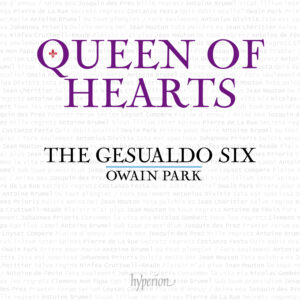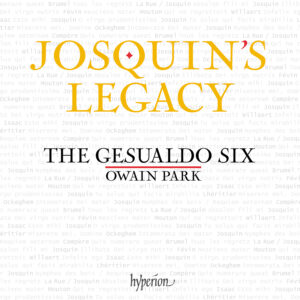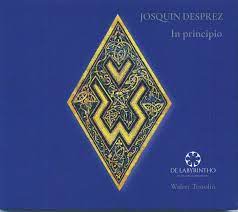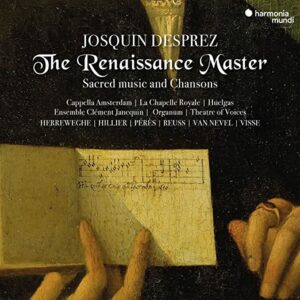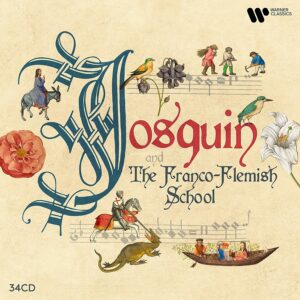Queen of Hearts
Gesualdo Six, Owain Park, director
Alasdair Austin, countertenor (final track only)
Hyperion Records, 2024
On Queen of Hearts, the low male vocal ensemble Gesualdo Six explores pieces devoted to queens, both the Virgin Mary (in her guise as Queen of Heaven), and queens from England and Continental Europe during the renaissance era. Some of the selections blur identities, linking the saintly actions of earthly monarchs with those of Mary.
The Song of Songs, from the Hebrew Bible, has an interesting place in both sacred and secular music of the Renaissance. In liturgical pieces, it is an insertion that venerates the Virgin Mary. In secular motet-chansons, it is often incorporated to make a connection between virtuous secular queens and Mary. As is their usual mode of operations, Gesualdo Six present a well-researched and musically inspired program. The eminent musicologist Guy James prepared editions of the music sung on Queen of Hearts, making it a bespoke collection that reflects the most recent and respected editorial trends.
The motet-chanson, particularly the regretz chansons, are a pivotal part of the program of Queen of Hearts. In the regretz genre, the beloved’s heart is broken because the desired one doesn’t reciprocate their affection or they aren’t available to each other. As James discusses in his excellent liner notes, the first regretz chansons were dedicated to Margaret of Austria, who had them collected in a large songbook, then called a chansonnier. Secret regretz, by Pierre de la Rue, begins in duet textures, eventually fanning out into four-voice polyphony. The poem’s author refuses to be defeated, asking for aid from fellow poets to raise his spirits. This response is against the grain of many regretz texts, suggesting that the genre didn’t cohere at first, exploring various themes before settling on just a few.
Several regretz chansons were dedicated to Anne of Brittany, who throughout her life had a series of relationships end in heartbreak. Jean Mouton’s De tous regretz was likely written while the composer was at Anne’s court. Gesualdo Six plays up the antiphonal passages with a slight accelerando, while liquescent legato lines provide the piece’s moving conclusion.
Antoine de Févin is represented by Fors Seulement, with tight upper duet constructions offset by registrally dispersed lower voices. There are multiple settings that honor “Gentle Févin” after his passing. It is speculated that Dulcis amica dei by Johannes Prioris might have been one. The piece’s melody was popular enough to be used by other composers at the French court. Another piece by Prioris, this one likely dedicated to Anne of Brittany upon her passing, Consommo la vita mia, is even more attractive, with each phrase beginning with slowly articulated melodic lines and concluding with achingly slow. chordal descents. Prioris should be better known, and it is typical of Gesualdo Six’s programming that they include such composers alongside those more frequently programmed. Only one composer from Italy appears on Queen of Hearts, but Costanzo Festa’s Quis dabit oculis is a riveting extended motet that also mourns the death of Anne. Its doleful chords and a proto-fugue are given an expressive performance by the ensemble.
Anne Boleyn’s songbook contained a number of pieces by Joquin, in addition those by other continental composers. Josquin’s Mille Regretz is perhaps the most popular of the genre. One can readily hear why; it is exquisitely well-constructed, with an initial architecture of leaps eventually filled in to make for a seamless conclusion. Praeter rerum seriem is a Marian motet with canons, beginning from the bass, with text describing the visitation of Mary by the Holy Spirit. The second section begins with an upper duet that then accumulates, top-down this time, into six-part writing. A favorite of mine from the Boleyn songbook is Antoine Brumel’s setting of a devotion to Mary, Sub tuum praesidium. Homophonic duets in the upper voices are juxtaposed with polyphony that begins its rise from the lowest voices. The resulting harmonies are gorgeous.
Two new pieces were commissioned for Queen of Hearts. One is by Gesualdo Six’s director, Owain Park, Prière pour Marie. The text is a prayer that was said to have been uttered by peasants about Mary Tudor when she was glimpsed traveling towards her wedding to Louis XII. “Mary on earth, Mary in the sky.” Park has a fine command of the polychords and chromatic tonal shifts frequently found in 21st century choral music. The piece’s declamation combines stacked verticals, and canons found amid other voices in free counterpoint. Its mood is portentous, as if the peasants have, by analogizing one queen to another, felt as if they have seen a divine vision. Plaisir N’ai plus by Nifea Cruttwell-Reade, is full of harmonic surprises, especially ones that resolve curiously against a pedal tone. In places, it appears that Cruttwell-Reade is repurposing the chromatic cadences that occurred in the renaissance to function in their own polytonal idiom.
The recording ends with one of the great pieces of the middle Renaissance, the Song of Songs setting Ego flos campi by Clemens non Papa. A seventh singer, the countertenor Alasdair Austin, is added to the performance. Perhaps Clemens’s best known piece, it is a beautiful treasure. Gesualdo Six plus one give a memorably expressive performance of it.
Queen of Hearts is both curated and performed with exquisite care. It is one of my favorites thus far of 2024.
Christian Carey
